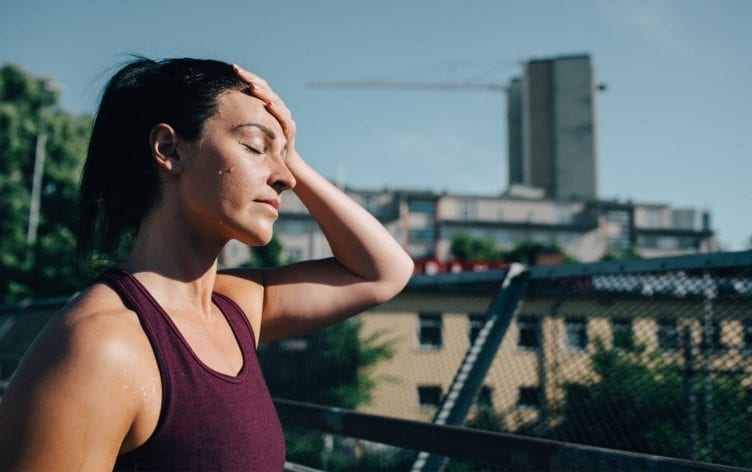
Summer months are usually a time when you can easily up your activity level by spending more time walking outdoors and trying new activities like hiking, swimming and cycling. But as the temperature starts to creep up, extreme heat can bring its own challenges, especially when you’re trying to increase your step count.
Here are 10 tips to help you stay on track with your walking routine during the year’s hottest months:
1
INVEST IN THE RIGHT GEAR
Cotton T-shirts and spandex leggings aren’t ideal choices for hot weather since they trap heat and sweat. Instead, invest in light-colored shirts, tank tops and shorts made of moisture-wicking materials designed for exercising outdoors in extreme temperatures. These items keep your skin dry, make you feel cooler, and are more comfortable. It’s also a smart idea to wear a lightweight hat and sunglasses that shield your face and eyes from the sun.
2
WALK EARLY OR LATE
While a late-morning or lunchtime walk can be a great idea in the spring and fall, during the summer, the sun’s UV index is highest between 11:30 a.m. and 1:30 p.m. Add in the rising temperatures during this time of day, and it’s easy to see why the early morning and late-evening hours are better choices for exercise. Getting in your workout first thing in the morning also makes it less likely you skip your walk altogether.
What’s more, exercising early in the day can also help boost your metabolism while an evening walk can aid digestion. If you opt for an evening walk, try closer to 8 p.m. when the sun is starting to set.
3
SPLIT UP YOUR WORKOUTS
If you’re into long-distance walking, getting in all of your miles at once can be a challenge during the summer — especially if you aren’t an early riser. Instead of suffering through a two-hour walk in extreme heat, consider breaking it up and walking half the distance in the morning and the other half in the evening.
Or, you can split up your workout in one session by starting outdoors and finishing on the treadmill.
4
FIND SHADE
Not all neighborhoods are lined with shady trees, which is why it’s always a good idea to wear lighter colors in summer and use high SPF sunscreen. While you might have to drive to get there, try heading to a trail or multi-use path out of direct sunlight to stay cool. If you can get away from the asphalt (which absorbs and holds heat), that’s even better. Walking on hilly terrain also burns more calories, so you won’t have to walk as far as you might normally to achieve the same weight-loss benefits. You can always listen to a good audiobook and get your workout done on a treadmill, too.
5
GET SERIOUS ABOUT HYDRATION
For anyone planning to walk more than 30 minutes at a time in hot weather, it’s a good idea to carry a water bottle or hydration pack. Staying hydrated throughout the day, in addition to when you exercise, helps your overall health, performance and weight-loss goals. It’s also a good idea to consider consuming a hydration beverage with electrolytes, important minerals that are lost via sweat.
READ MORE > DOES YOUR WATER NEED A BOOST?
6
CONSIDER CUTTING BACK ON CAFFEINE
While small amounts of caffeine might be OK, it can also have a diuretic effect. Caffeine should also be avoided pre-workout if you have cardiovascular risk factors such as high blood pressure or high cholesterol since some research shows it could increase the risk of blood clots.
7
MONITOR YOUR URINE COLOR
One of the ways you can tell if you’re adequately hydrated is to monitor the color of your urine. This is helpful not only following your workout but also in the days prior to a particularly hard effort. Urine that is cloudy or darker in color is a signal you need to up your hydration efforts, while lighter, pale urine is a sign your hydration levels are on track.
8
WEIGH YOURSELF
One quick way to test your hydration levels is to weigh yourself before and after your workout. On average, every pound you’ve lost is equal to about 16 ounces of fluid. To ensure you’re adequately hydrated, shoot to replenish this plus an additional 6–8 ounces. A few pounds of weight loss for long workouts is normal, but if you’re seeing extreme drops, the chances are you’re not hydrating enough during your workout and need to carry more water.
9
CONSIDER AN ALTERNATIVE REHYDRATION BEVERAGE
In really hot weather and for longer workouts over an hour, a sports drink might be needed to replenish lost electrolytes and sodium. Just make sure you go for an option that isn’t processed or from concentrate, as these can be higher in sugar and added sweeteners. One natural option is coconut water, which can help you hydrate while providing electrolytes. You can also try chocolate milk, which has a good blend of carbohydrates and protein to help your muscles recover while also providing vitamins A and D, calcium and magnesium.
10
PLAN AHEAD FOR LONGER WALKS
If you’re walking for more than an hour, plan ahead by choosing a route that allows you to refill at a water fountain. An alternative option is to drive the route beforehand and stash an extra water bottle or two at specific locations so you won’t have to carry extra weight.
Originally published July 2019, updated with additional reporting
Make progress every day while you work on fitness goals, like walking more steps. Go to “Plans” in the MyFitnessPal app for daily coaching and easy-to-follow tasks to keep you motivated.
TagscardioFitness Tipshydrationtraining tipswalkingwarm-weatherwater